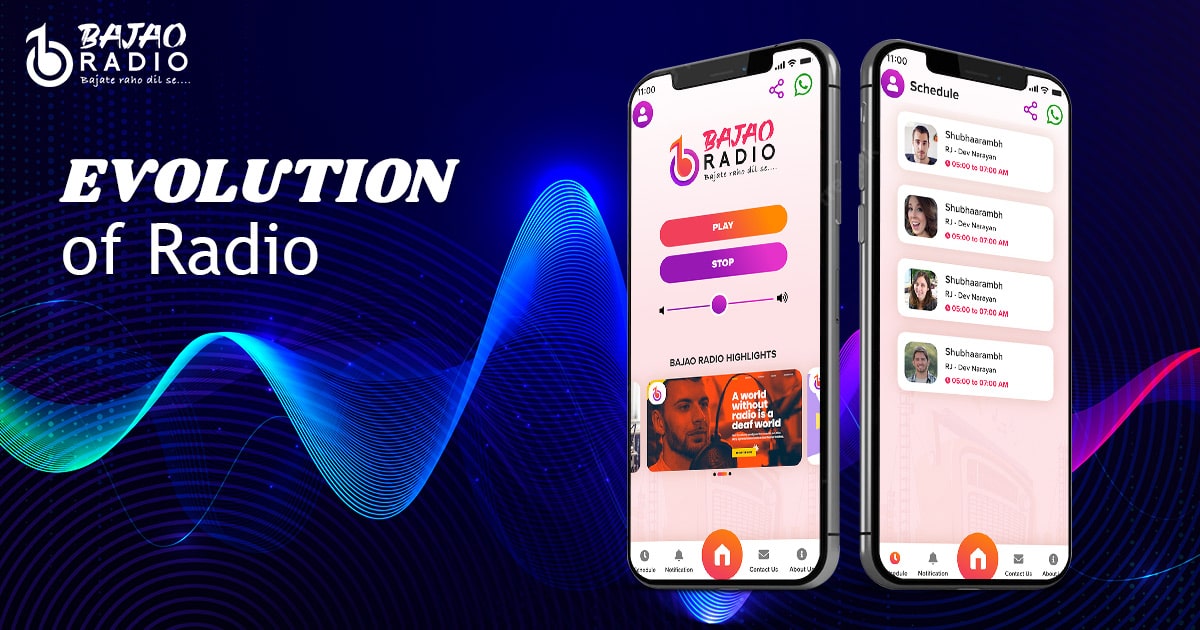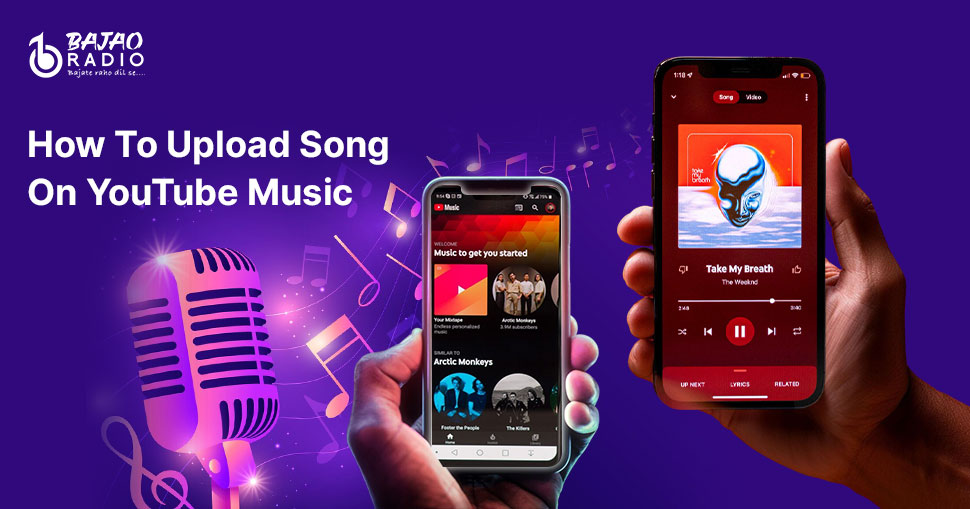Do you head towards FM radio or the apps that play online radio whenever you are feeling bored or want some entertainment? If yes, the question would have hit your mind, “How has online radio developed”? For a very long period, the radio has been a significant mode of communication between populations worldwide. However, not only has the radio changed the way of mass communication but also the technology has led to the “evolution of radio”. Radio began with the introduction of big wooden boxes used to get insight into world information in a breaking voice. Now we have radio stations on our smartphones with much better sound quality and more radio stations.
In this blog, we will be talking about the evolution of AM and FM along with the complete history of radio. From analog beginning to digital radio, the evolution of radio has played a significant role in the broadcasting sector by enhancing connectivity and delivering diverse content to a worldwide audience. Let's dive deeper into the blog and find out how the FM transformed over the years and have a glance over the history of radio’s technological advancements.
History Of Radio
The history of radio comes from a century back when Guglielmo Marconi worked on the wireless telegraphy during the 1800s. The first monumental achievement in this field was observed in 1901 when the first successful transatlantic transmission.
The year 1920 was the other historic milestone with the introduction of KDKA which brought commercial radio and scheduled broadcasting into radio history. The 1930s was the golden age of Radio engaged the audience in serialized dramas and live music to foster a collective cultural experience.
As time passed, there were a lot of improvements introduced in the history of radio with innovations like portable transistor radios in the 1950s that completely reshaped the way audience consumed music. Moving ahead, we saw the diverse formats of radio like digital platforms for the same which made it easier to disseminate information, provide entertainment, and contribute extensively to the evolution of radio.
Radio History In India
The history of radio in India comes from the late 1990s when private organizations were permitted to enter the nation’s broadcasting and FM sector. Before the private radio stations entered the radio history in India, the All India Radio used to rule the sector in the country. The launch of Radio City 91.1 FM in Bangalore in 2001 made a significant turn in the radio landscape of the nation which encouraged the further growth of FM stations nationwide. Moving ahead, radio stations like Big FM, Red FM, and Radio Mirchi further redefined the scenario by providing access to diverse music genres, culturally tailored content, engaging talk shows, news in regional languages, and much more.
The main reason behind the success of FM radio in India is its grassroots connections that promote local talent, address societal concerns, and thus create a strong rapport with the local communities. As digital transformation and digital platforms came together, radio became the main medium for entertainment, information dissemination, and cultural representation. This evolution marked another milestone in radio history making FM the ruling technology in India’s media landscape and its deep resonance with listeners all over the country.
Evolution Of Radio - Technological Advancements
The evolution of radio in India as well as the whole world is led by significant technological improvements in analog radio that introduced the use of a box for entertainment, information, and much more. Here are some of the milestones that explain this complete journey:
1. AM and FM Radio Broadcasting
Both the AM and FM have played a core role in the evolution of radio in India. AM helped to encourage long-distance transmissions of the information to support the radio reach and accessibility, FM radio broadcasting on the other hand contributed significantly to revolutionizing sound quality and providing a better experience to the listeners.
2. Transistor Radios
The introduction of the transistor radio in the 1950s was another momentous milestone in the history of radio. These were the pocked-sized devices consisting of vacuum tubes. These radios were very cost-effective, compact as well as energy-efficient. This innovation eliminated the constraints of distance and time, fostering a wider reach of radio among the target audience. Also, transistor radios completely reshaped the listening habits of people due to their mobility.
3. Portable and Car Radios
The evolution of radio received another transformation with the inception of portable and in-car radios. This evolution made it easier for everyone to carry their favorite radio stations anywhere they wanted while eliminating the need for hefty transistors. At the same time, the car radios brought fun to car drives and traveling times which further reshaped the way people consume music, news, and information in their everyday lives.
Limitations Of Analog Radio
While there were many benefits associated with analog radio, still some of its drawbacks made it inferior to digital radio. Here are some of the limitations that people experienced with analog radio:
1. Signal Interference
There was a lot of signal interference in analog radio which would restrict the fun time and news time. The interference could be caused by atmospheric conditions, electrical appliances, physical obstacles, and much more. So, people often used to compromise with the sound quality of radio and thus people were looking for a more seamless experience.
2. Limited Channel Capacity
The history of radio changed when the listeners experienced a lack of choices in channels when using FM radio. The limited channel capacity resulted in the competition for allocation, lack of diversity in programs, and thus, only serving limited content to listeners around the nation.
3. Sound Quality
Another big cause that caused the shift from analog radio is its poor sound quality. Due to the vulnerability to noise and distortion, the sound quality in analog radio was compromised heavily and thus affected the expected sound quality from listeners. It was a big obstacle in a fun time for listeners.
Evolution Of Radio: From Analog to Digital Broadcasting
Because of the limitations associated with analog radio, the evolution of radio was ready for the shift to digital broadcasting for a better experience. The vision of this transition was to enhance the quality of radio and elevate the listening experience of the users by eliminating all the drawbacks of analog radio.
The induction of digital radio completely changed the radio landscape by overcoming all the analog radio limitations. Digital radio converts audio signals into digital data and thus begins the new era of broadcasting. This system uses binary-formatted data that ensures flawless sound reproduction thus enhancing the overall user experience with better sound quality. This was one of the biggest milestones in the history of radio, causing a significant shift from analog radio to digital technology.
Advantages Of Online Radio
There is no doubt that analog radio ruled the world for a very long time. However, online FM radio brought some advantages in the evolution of radio that made it one of the most preferred modes of entertainment for people worldwide. Let's have a glance over these advantages:
1. Enhanced Sound Quality
By eliminating the drawbacks of analog radio, online radio led the world to an immersive experience of digital radio with enhanced sound quality. The crystal clear audio of online radio took the audience on a melodious aural journey and thus elevated the listening experience of the people.
2. Increased Channel Capacity
The history of radio experienced a big change when online FM radio brought the increased channel capacity into existence. This enabled the radio landscape to further provide a diverse and wide range of content, tailored especially according to the people coming from different cultures, backgrounds, and regions.
3. Additional Services
Another big benefit of online radio is that it took the scenario above the mere audio experience. By introducing multimedia formats, the online FM radio delivered live written information to traffic updates, weather reports, and features like song identification and purchase.
Also Read: Bajao Radio's Mobile App: Your Ticket to On-the-Go Entertainment
Different Online Radio Standards
The history of radio is full of different digital radio standards, and each of them carries its unique implementations and requirements. Here are some of the renowned digital radio stations:
1. HD Radio
HD Radio was an innovation by iBiquity Digital Corporation that marked a significant shift in the evolution of radio. Through the transmission of analog and digital signals, this innovation revolutionized the radio listening experience by providing better sound quality, accessibility to more channels, and helping listeners immerse themselves in a spectacular audio experience.
2. Digital Audio Broadcasting (DAB)
DAB, also known as Eureka 147, emerged as a popular digital radio standard in Europe, Asia, Australia, and other selected regions that brought a big change in the history of radio. As a successor of analog radio, Digital Audio Broadcasting provided better sound quality, and thus enhanced the user experience by bringing more options to radio stations.
3. Digital Radio Mondiale (DRM)
DRM was designed specifically for signal transmission across long, short, and medium-wave bands that brought the revolutionary shift in digital radio. This evolution enabled the broadcasters to offer high-quality audio services to people while enhancing the reception standards. This step was a great relief for the areas where analog transmission is always an issue. The enhanced audio quality promise by DRM brought the attention of listeners, enhancing a strong brand position as an influential force in digital radio.
Impact of Online Radio on Broadcasting
Online radio contributed significantly to the evolution of radio by bringing better sound quality, a range of channel choices, and much more. At the same time, various limitations of analog radio were eliminated enhancing the user experience significantly.
The increased channel capacity made it easier for the broadcasters to provide content for different demographies which increased the quality as well as quantity of information. Thus, the radio industry evolved into a more diversified and vibrant landscape that generated more possibilities in the history of radio.
Moreover, this evolution in the history of radio expanded the traditional audio content to explore the new era of ancillary services. A range of information could be accessed via online radio including the different offerings, text information displays, updates on real-time traffic, weather reports, and much more.
The Future of Online Radio Apps
The online radio apps are all set to carve their name with gold in the journey of evolution of radio, all because of the different technological advancements. A plethora of innovations have been introduced in the journey including internet radio, streaming services, personalized radio experiences, and much more. The complete radio industry is headed toward growth and transformation, encouraging a more personalized listening experience for users and leading to a significant spike in radio preferences. Surprisingly, phone calls can also be facilitated over radio frequencies now.
Even in India, several online radio apps can be used for listening to different radio programs anytime and anywhere. However, it is still very difficult to find a genuine app among the crowd flooded with different APKs and useless software. So, it is recommended to rely only on reputable online radio apps in India that offer free and reliable streaming services.
Also Read: 10+ Free Radio Websites 2024
Factors to Consider While Choosing an Online Radio App
Here are the five major factors that must be considered when selecting an online radio app:
1. Content Variety
The foremost factor that you must consider while selecting the online radio app is the content variety. The application must cater to diverse radio stations, genres, and podcasts according to various preferences and moods.
With a wide range of content variety, the listening experience gets better. Whether the listener wants to listen to music, hear the news, or access talk shows, the availability of diverse content makes the radio app an all-in-one solution. The content variety enables the user to dive deeper into their interests and find the content they prefer.
2. User-Friendly Interface
Just like the content, it is important to have an intuitive and seamless user interface that navigates the users through different features and functionalities of the application. Tasks like finding radio stations, creating playlists, enhancing the overall user experience, and leveraging the different features become easy with a good UI.
The intuitive and simpler interface enables the users to focus and explore the application without getting confused by the complexities. Hassle hassle-free experience brings the users again and again to the application.
3. Sound Quality
You will only be able to enjoy music and radio for a short period if the sound quality is good. So, make sure that the mobile radio app you are choosing offers a good sound quality and adjusts itself according to the available internet connection.
The good sound quality enhances the overall enjoyment and enables the users to immerse in their music playlist without getting irritated. This provides a more enriching listening experience to the vast audience base.
4. Offline Listening
While most mobile apps only run with internet connection, you can find online radio apps that offer unstoppable fun and music experiences even when not connected to the internet. Options like song download, offline FM radio, and offline access to different radio stations elevate the user experience and make the application even more preferable to the audience.
5. Cost Factor
There are different pricing associated with the different types of apps. So, you must analyze the monetization model of the app whether it is completely free, offer premium features, or there are in-app purchases. Similarly, a lot of advertisement interruptions can also ruin your experience, which is why you should assess this factor efficiently. Depending on your budget and music taste, choose the right online radio app.
Conclusion: Evolution of Radio
The evolution of radio travels back from analog radio to digital broadcasting, introducing various chapters in the history of radio. The complete journey of radio in India is full of new surprises, innovation, enhanced user experience, and various supplementary experiences. Starting from the analog radio with hefty transistors to the car radio and online radio apps, the history of radio has entirely changed the way people consumed music, information, traffic, and weather reports on the radio. Moving ahead, the arrival of digital radio made a significant improvement in the sound quality, number of channels, mobility of radios, etc. The technological advancements continued to unfold radio history and shaped the dynamic future of radio.
FAQs
1. What is Analog Radio?
In analog radio, works on the principle of continuous analog waveforms. On the other hand, digital radios utilize digital encoding for signal reception and transmission. Continuous waveforms are important for the continuous working of analog radio.
2. How Online Radio Has Boosted the Industry?
Online radio has brought better sound quality, more radio stations, signal reliability, better mobility, offline access, diverse content, and a personalized set of music and news.
3. Which is the Best Online Radio Mobile App?
Bajao Radio is considered one of the best online radio mobile apps that offers a range of music, news, live shows, and much other content for users coming from different backgrounds, and cultures.
Latest Blogs
Radio Broadcasting: All You Need To Know
When we talk about the world of communication, then radio broadcasting remains the most popular and loyal medium over decades. It has been a top source for the latest news, entertainment, talk shows, ...
Continue Reading10 Best Radio Stations In Chandigarh
Entertainment is one of the most essential aspects of our life. The thirst for entertainment is perpetual, and people are always looking for new options to entertain themselves. However, one thin...
Continue ReadingHow To Upload Song On YouTube Music
Are you an artist or a music lover who is struggling to upload songs to YouTube? Don’t worry; we are here to help you and let you know how to upload song on YouTube. In this modern world, Y...
Continue Reading



